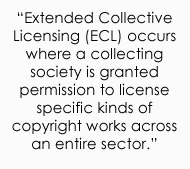 On the 1st October 2014, the Copyright and Rights in Performances (Extended Collective Licensing) Regulations 2014 came into force in the UK.1
On the 1st October 2014, the Copyright and Rights in Performances (Extended Collective Licensing) Regulations 2014 came into force in the UK.1
Licensing bodies and collecting societies already operate within the UK, providing rights management and licensing services for their rightsholder members across a range of sectors including publishing, art and design, music and performance.2 Extended Collective Licensing (ECL) occurs where a collecting society is granted permission to license specific kinds of copyright works across an entire sector, thereby representing the interests of non-member rightsholders in addition to those of their own members. ECL was first developed in the Nordic countries in the 1960s to simplify the process of mass-licensing broadcast material.3
The scheme is intended to deliver a number of benefits. The Hargreaves Review recommended the implementation of ECL in the UK in 2011, noting that a streamlined licensing regime would be, “good for users by providing legal certainty, good for creators because it delivers remuneration, and good for consumers because it extends access to works.”4
 Instead of engaging in time-consuming rights clearance, users will be able to obtain mass, non-exclusive licences directly from collecting societies to cover a range of uses, and rightsholders will be assured of remuneration for their works.
Instead of engaging in time-consuming rights clearance, users will be able to obtain mass, non-exclusive licences directly from collecting societies to cover a range of uses, and rightsholders will be assured of remuneration for their works.
Under the auspices of the UK scheme, permission to operate an ECL scheme is granted subject to safeguards. The collecting society must be able to demonstrate “significant” representation for the particular type of work which is to be licensed,5 and must obtain consent from their members.6 Non-member rightsholders of those specified copyright works must be provided with the option of opt-out from the scheme,7 either for some or all of their works (although once ECL is established, opting-out is generally rare). Existing collecting societies that wish to apply for permission to engage in ECL will be expected to review their codes of practice: to ensure clear governance, improve transparency and provide clear and concise information to users, members and non-members alike.8 They must also provide sufficient publicity about the ECL scheme, and create mechanisms for the distribution of licence fees to non-member rights holders.9
The UK Intellectual Property Office (UK IPO) conducted a consultation process to develop the legislation during 2014, and a number of issues have been raised about the scheme by rightsholders, collecting societies and potential licensees. The main concerns expressed included: determining and evidencing the threshold of representation required for a collecting society to successfully apply for ECL scheme authorisation;10 the evidence required, and the review process for the renewal of ECL scheme authorisation;11 making sure that the opt-out option for non-members is viable;12 clarifying how unclaimed fees can be redistributed;13 and the proposed 5-year duration of the scheme authorization period, which some licensees worry will be too short.14
 Supporters of ECL include cultural heritage organisations (including the Wellcome Trust, British Library, and British Film Institute),15 although it is important to note that with the legislation in its current form, archives, museums and libraries may only find ECL useful for particular types of material. For example, archive collections like personal papers are mainly composed of copyright works, but these are works for which collecting societies cannot claim any representation: correspondence, archival records, unpublished manuscripts.16 Given that much of this archive material was produced on a non-commercial basis, and that when permission to digitise is sought rights holders typically do not request permission fees, paying a collecting society for a licence may not make the best financial sense for some cultural institutions.17 During the consultation process, these institutions argued that the potential ‘public interest’ function of ECL should be more clearly articulated: this is based on the Nordic ECL system, where the “educational and cultural benefits” of the scheme were primary drivers for the legislation.18
Supporters of ECL include cultural heritage organisations (including the Wellcome Trust, British Library, and British Film Institute),15 although it is important to note that with the legislation in its current form, archives, museums and libraries may only find ECL useful for particular types of material. For example, archive collections like personal papers are mainly composed of copyright works, but these are works for which collecting societies cannot claim any representation: correspondence, archival records, unpublished manuscripts.16 Given that much of this archive material was produced on a non-commercial basis, and that when permission to digitise is sought rights holders typically do not request permission fees, paying a collecting society for a licence may not make the best financial sense for some cultural institutions.17 During the consultation process, these institutions argued that the potential ‘public interest’ function of ECL should be more clearly articulated: this is based on the Nordic ECL system, where the “educational and cultural benefits” of the scheme were primary drivers for the legislation.18
From the consultation, it would appear that in this case, the primary drivers for the legislation are regulating the collecting societies, and protecting and ensuring remuneration for rightsholders. It is also important to note that ECL schemes have their limitations. The scheme is limited by the fact that licences can only be granted for the use of works within the UK. There is also the possibility of a conflict of interest: licensees may benefit from the option of applying for a licence without having to engage in a diligent search, but this responsibility is then passed on to the collecting society, something they may not have the time or inclination to spend resources on for non-members, or for overseas rightsholders.19 It is hoped that the safeguards contained in the legislation, and especially the requirement for codes of practice, will be robust enough to prevent these conflicts from occurring.
Dr. Dinusha Mendis, Associate Professor in Law, Co-Director Centre for Intellectual Property Policy and Management, Bournemouth University
Ms. Victoria Stobo, PhD Candidate, CREATe, RCUK Centre for Copyright and New Business Models in the Creative Economy, University of Glasgow
1. Copyright and Rights in Performances (Extended Collective Licensing) Regulations 2014, S.I. 2588. Available at: http://www.legislation.gov.uk/uksi/2014/2588/regulation/4/made
2. For example, see the Design and Artists Copyright Society (DACS) at http://www.dacs.org.uk/home ; the Copyright Licensing Agency (CLA) at http://www.cla.co.uk/ ; the Performing Right Society (PRS for Music Ltd) at http://www.prsformusic.com/Pages/default.aspx ; or the Newspaper Licensing Agency (NLA) at http://www.nlamediaaccess.com/default.aspx?tabId=40.
3. Riis, T., and Schovsbo, J., “Extended Collective Licences and the Nordic Experience: It’s a Hybrid but is it a Volvo or a Lemon?” (2009-2010) Columbia Journal of Law and the Arts 471-98, 473-76.
4. Hargreaves, I., Digital Opportunity: A Review of Intellectual Property and Growth (May 2011), available at: http://www.ipo.gov.uk/ipreview-finalreport.pdf (Page 38)
5. Copyright and Rights in Performances (Extended Collective Licensing) Regulations 2014, S.I. 2588, r.4.b. Available at: http://www.legislation.gov.uk/uksi/2014/2588/regulation/4/made
6. Ibid, r.4.f
7. Ibid, r.4.d
8. Ibid, r.4.c
9. Ibid, r.4.e
10. See https://www.gov.uk/government/consultations/extending-the-benefits-of-collective-licensing
11. Ibid
12. Ibid
13. Ibid
14. Ibid
15. Ibid
16. Deazley, R., and Stobo, V. (2013) Archives and Copyright: Risk and Reform. Working Paper. CREATe / University of Glasgow, Glasgow, UK. p. 49. Available at https://zenodo.org/record/8373/files/CREATe-Working-Paper-2013-03.pdf
17. Ibid, p.37
18. See the consultation responses provided by the British Library(p.1) and the Wellcome Trust (p.2) at https://www.gov.uk/government/consultations/extending-the-benefits-of-collective-licensing
19. Deazley, R., and Stobo, V. (2013) Archives and Copyright: Risk and Reform. Working Paper. CREATe / University of Glasgow, Glasgow, UK. p. 38. Available at https://zenodo.org/record/8373/files/CREATe-Working-Paper-2013-03.pdf
________________________
To make sure you do not miss out on regular updates from the Kluwer Copyright Blog, please subscribe here.


